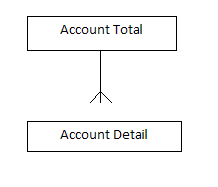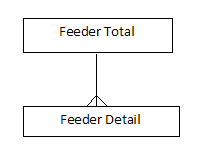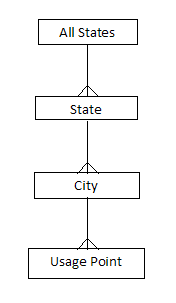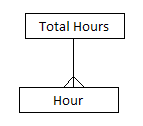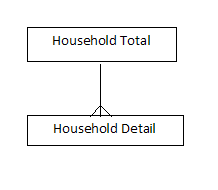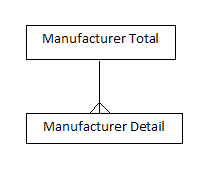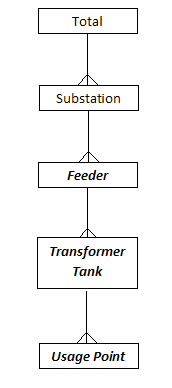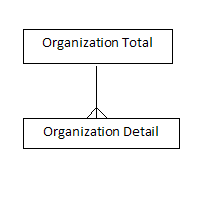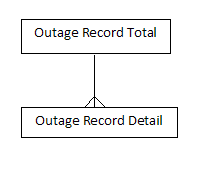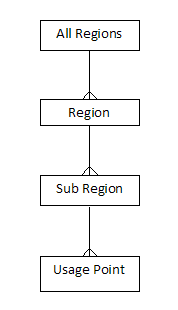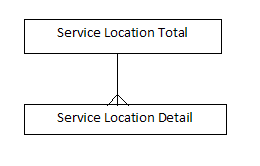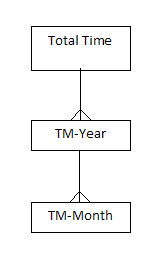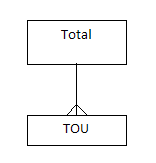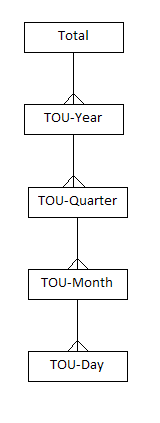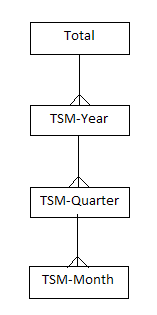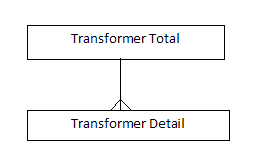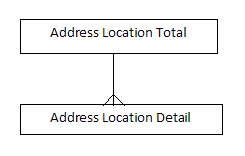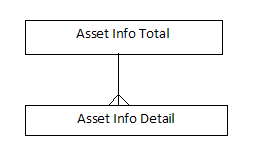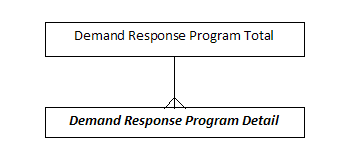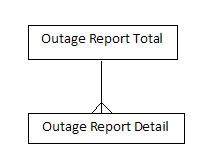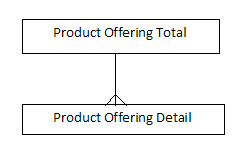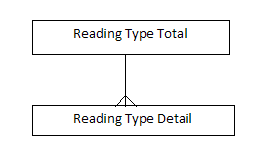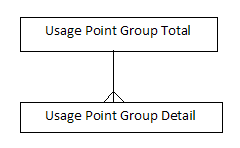3 Logical Data Model Dimensions
This chapter describes the logical dimensions and hierarchies of Oracle Utilities Data Model.
Logical Data Model Dimensions
This sections lists the logical data model dimensions.
- Account
- Customer
- Feeder
- Geography Zone
- Hour
- Household
- Manufacturer
- Meter
- Operational
- Organization
- Outage Record
- Postcode
- Product Asset Model
- Region
- Service Location
- Substation
- Time
- Time Month Day Hour
- Time Month
- Time Month Hour
- TOU
- TOU Time
- Time Season Month
- Time Season Month Hour
- Transformer
- Usage Point
- Usage Point Location
Account
Description: Account
Account Levels
Table 3-1 shows Account Total: All ACCOUNT is the most aggregate level of the dimension.
Table 3-1 Account Total
| Sr. Number | Attribute | Description |
|---|---|---|
|
1. |
ALL ACCOUNT CODE |
Identification for the top level value. |
Table 3-2 shows Account Detail: The account tracks the financial interactions of a customer with the utility. It is normally generated by a contract between the utility and customer. One customer may have multiple accounts.
Table 3-2 Account Detail
| Sr. Number | Attribute | Description |
|---|---|---|
|
1. |
Account Code |
Sample value: 2006012514 |
|
2. |
Account Code1 |
No value |
|
3. |
Organization Business Unit Code |
No value |
|
4. |
Account Segment Code |
No value |
|
5. |
Account Type Code |
Sample value: Electricity |
|
6. |
Accounting Cycle Code |
No value |
|
7. |
Billing Cycle Code |
No value |
|
8. |
Billing Period Code |
No value |
|
9. |
Currency Code |
Sample value USD |
|
10. |
Credit Category Code |
Code for credit category. |
|
11. |
Party Code |
A code for any person or business that is of interest to the utility. |
|
12. |
Source System Code |
No value |
|
13. |
Payment Method Type Code |
No value |
|
14. |
Billing Frequency Code |
No value |
|
15. |
Account Role Type Code |
Sample value: PRPD |
|
16. |
Account Status Type Code |
No value |
|
17. |
Account Status Reason Code |
No value |
|
18. |
Customer Visible Code |
The account number visible to the customer. |
|
19. |
Secondary Currency Code |
Secondary currency for this bill info. A/R can be viewed and payments/disputes/adjustments made in the secondary currency, but all impacts are translated to the primary currency for actual A/R tracking. Only euro and EMU currencies are supported as secondary. |
|
20. |
Billing Status Code |
Used to track the billing status of a bill info. Legal values are BILL_ACTIVE - indicates that billing should be provided for the account in a standard (regular) way. This is a default value. BILL_INACTIVE. |
|
21. |
Billing Status Reason Code |
Indicates a reason for changing of BILLING_STATUS. |
|
22. |
Create Staff |
The employee who created the account. |
|
23. |
Advertising Status |
The account setting regarding advertisement, for example, allow SMS marketing, forbid SMS marketing. |
|
24. |
Account Charge Type |
The charge type of the account. For example: Prepaid, or Postpaid. |
|
25. |
Source System Identifier |
The identifier in the source system, as specified by source system key (code). |
|
26. |
Payment Comment |
The textual note attached to the payment. |
|
27. |
Account Description |
No value |
|
28. |
Create Date |
For example: 22-JAN-08 |
|
29. |
Termination Date |
For example: 21-SEP-08 |
|
30. |
Account Effective Date |
Effective time of modification of this account on an external system. For example, if this account is created by billing system, this date may refer to when this account is activated in CRM system. |
|
31. |
Initial Activation Date |
The date when the account was activated. |
|
32. |
Last Activate Date |
The last time this account is activated. |
|
33. |
Last Suspend Date |
No value |
|
34. |
Last Reopen Date |
No value |
|
35. |
Group Plan Indicator |
No value |
|
36. |
Multiple Customer Indicator |
To indicate this account is used by multiple customers. |
|
37. |
Payment Days |
The default payment due days for invoices. |
|
38. |
Close Grace Period |
Number of days (months) before the account is suspended if the balance is below zero. During this period account may be functional with limitations, like no outgoing calls. |
|
39. |
Balance Expire Period |
Number of days (months) before the account balance expires. |
|
40. |
Close Period |
Number of days (months) before the account is closed (or suspended), if the balance is below zero. Accounts in this state maybe recovered. |
|
41. |
Close Purge Period |
Number of days (months) before the account is closed and purged if the balance is below zero. |
|
42. |
Warning Balance Level |
The balance level bar for warning period. For example, if customer balance is < $5, then customer receive warning messages. |
|
43. |
Close Balance Level |
The balance level below which the customer account may be closed after a period. |
|
44. |
Effective From Date |
No value |
|
45. |
Effective To Date |
No value |
|
46. |
Status Code |
For example: A |
|
47. |
Account Name |
No value |
|
48. |
In Platform Code |
Id for IN platform. |
Customer
Description: Customer
Customer Levels
Table 3-3 shows Customer Total: All CUSTOMER is the most aggregate level of the dimension.
Table 3-3 Customer Total
| Sr. Number | Attribute | Description |
|---|---|---|
|
1. |
ALL CUSTOMER CODE |
Identification for the top level value. |
Table 3-4 shows Customer Detail: All the customers, including individual and organization customers. A customer is generally defined as a party using one or more services from the operator.
Table 3-4 Customer Detail
| Sr. Number | Attribute | Description |
|---|---|---|
|
1. |
Customer Code |
For example: CUST-10561 |
|
2. |
Customer Kind Code |
Kind of customer. |
|
3. |
Customer Score Code |
No value |
|
4. |
Customer Segment Code |
No value |
|
5. |
Customer Source Code |
No value |
|
6. |
Customer Type Code |
For example: Commercial |
|
7. |
External Organization Type Code |
No value |
|
8. |
Language Code |
No value |
|
9. |
Prospect Code |
No value |
|
10. |
Status Code |
No value |
|
11. |
Planned Outage Code |
No value |
|
12. |
Address Location Code |
No value |
|
13. |
Job Code |
Code for job of subscriber. |
|
14. |
Household Code |
No value |
|
15. |
Customer Revenue Band Code |
No value |
|
16. |
Nationality Code |
Code for nationality of subscriber. |
|
17. |
Education Code |
Code for educational qualification of subscriber. |
|
18. |
Other Individual Code |
No value |
|
19. |
SOC Job Code |
No value |
|
20. |
Marital Status Code |
Code for marital status of subscriber. |
|
21. |
Gender Code |
Code for gender. |
|
22. |
Billing Address Location Code |
The address where the billing is sent to. |
|
23. |
Chairman Code |
No value |
|
24. |
Party Organization Type Code |
No value |
|
25. |
Death Certificate Code |
No value |
|
26. |
Manager Code |
No value |
|
27. |
Campaign Partner Code |
The campaign partner code if this customer at the same time is also a campaign partner. |
|
28. |
Sales Volume Code |
No value |
|
29. |
Contact Code |
No value |
|
30. |
Referral Customer Code |
Some commission or loyalty program depends on this information to calculate the bonus. |
|
31. |
Company Registry Number |
No value |
|
32. |
Driver License Number |
No value |
|
33. |
DUNS Number |
The data universal numbering system code, as from D&B. |
|
34. |
Employer Tax Number |
The tax number of the employer from tax authority. |
|
35. |
Prev Employer Tax Number |
No value |
|
36. |
Social Security Number |
Social security number for individual customer. |
|
37. |
Job Contract Type |
No value |
|
38. |
Tax Exempt Status |
No value |
|
39. |
Tax Number |
Tax number of the party, for both individual and organizational. |
|
40. |
Initiative Number |
The initiative code as defined in initiative entity. For example, when a person register himself on the operator`s website, he becomes an initiative. Later on, once he places the order, he becomes the customer. In the customer table, imitative number track. |
|
41. |
Primary Occasion Name |
Default customer occasion type name. For example, the marriage anniversary. |
|
42. |
Primary Status Code |
Unique identifier for the primary Status. |
|
43. |
Primary Status Name |
Default Status Name. |
|
44. |
Primary Status Reason Code |
Unique identifier for the primary Status Reason. |
|
45. |
Primary Status Reason Name |
Name of the primary status reason. |
|
46. |
Seal Image |
The image files of customer signature, or stamp. |
|
47. |
Manager Name |
No value |
|
48. |
Contact Name |
No value |
|
49. |
Stock Exchange Name |
No value |
|
50. |
Name Prefix |
No value |
|
51. |
Name Suffix |
No value |
|
52. |
First Name |
Sydney |
|
53. |
Last Name |
Kerry |
|
54. |
Middle Name |
No value |
|
55. |
Family Name In Maiden |
No value |
|
56. |
Given Name In Maiden |
No value |
|
57. |
Name Of Workplace |
No value |
|
58. |
Place Of Birth |
No value |
|
59. |
Job Position |
Financial Analyst |
|
60. |
Legal Title To Housing |
No value |
|
61. |
Ethnic Background |
No value |
|
62. |
Number Of Children |
No value |
|
63. |
Number Of Dependents |
No value |
|
64. |
Dwelling Tenure |
28 |
|
65. |
Dwelling Size |
For example: 33290 |
|
66. |
Ethnicity |
No value |
|
67. |
Form Of Employment |
No value |
|
68. |
Dwelling Type |
For example: LEASED |
|
69. |
Dwelling Status |
No value |
|
70. |
Office Tel No |
This is the office number, and more contact information can be found in _party contact information_. |
|
71. |
Cell Phone No |
The cell phone number, and more contact information can be found in _party contact information_. |
|
72. |
Personal Identification Number |
No value |
|
73. |
Source Of Income |
For example: Business Income |
|
74. |
Payment Account Number |
Account number for payments. Deprecated: This one is only used for backward compatibility. |
|
75. |
PUC Number |
(if applicable) Public utility commission (PUC) identification number. |
|
76. |
Special Need |
True if customer organization has special service needs such as life support, hospitals, and so on. |
|
77. |
Living At Current Address Since |
No value |
|
78. |
End Of Job Contract |
No value |
|
79. |
Start Of Employment |
No value |
|
80. |
Prev Employment Start Date |
No value |
|
81. |
Prev Employment End Date |
No value |
|
82. |
Final Settlement Start Date |
The start date of the period when this customer lives in the last known area. |
|
83. |
Final Settlement End Date |
The end date of the period when this customer lives in the last known area. |
|
84. |
Date Of Birth |
The birthday of the customer, for individual customers. |
|
85. |
Establishment Date |
Time of establish for organizational customer. |
|
86. |
Termination Date |
The natural termination date of organizational and individual customer. |
|
87. |
Validation Start Date |
The business license validation period start date. |
|
88. |
Validation End Date |
The business license validation period end date. |
|
89. |
Liquidation Start Date |
The start date of liquidation process. |
|
90. |
Liquidation End Date |
The end date of liquidation process. |
|
91. |
Contact Address Effective Date |
Date on which the contact address referenced in the billing_address_id column became active. This facilitates queries such as ``find customers who changed address in the last 3 months``. |
|
92. |
Billing Address Effective Date |
Date on which the billing address referenced in the billing_address_id column became active. This facilitates queries such as ``find customers who changed address in the last 3 months``. |
|
93. |
Payment Account Open Date |
Opening date of the first account with valid payment information. Deprecated: This one is only used for backward compatibility. |
|
94. |
Payment Account Close Date |
Closing date of the first account with valid payment information. Deprecated: This one is only used for backward compatibility. |
|
95. |
Create Date |
The date when this customer record is created. This can be same as first account create date, or first contract setup date. |
|
96. |
Economically Active Indicator |
For example: N |
|
97. |
Public Indicator |
To indicate this is public listed company (listed and traded in stock exchange market). |
|
98. |
Domestic Indicator |
To indicate this is a domestic company (compared with overseas, or those from other country). |
|
99. |
Campaign Partner Indicator |
To indicate this is a campaign partner. |
|
100. |
Mail Allowed Indicator |
Indicates if marketing information can be sent to the customer. |
|
101. |
Third Party Marketing Allowed Indicator |
Specifies whether to allow third party to do marketing to the customer. |
|
102. |
Customer Payment Responsible Indicator |
Indicate if this customer is responsible for payment of a customer organization or household. |
|
103. |
VIP |
True if this is an important customer. Importance is for matters different than those in `SpecialNeed` attribute. |
|
104. |
Employee Count |
No value |
|
105. |
Annual Revenue |
No value |
|
106. |
Annual Revenue Local |
No value |
|
107. |
Annual Revenue Reporting |
No value |
|
108. |
Annual Sales |
For example: 246140617 |
|
109. |
Annual Sales Local |
No value |
|
110. |
Annual Sales Reporting |
No value |
|
111. |
Equity Amount |
For example: 659037373 |
|
112. |
Equity Amount Local |
No value |
|
113. |
Equity Amount Reporting |
No value |
|
114. |
Effective From Date |
No value |
|
115. |
Effective To Date |
No value |
|
116. |
ARPU Band Code |
No value |
|
117. |
Churn Date |
In porting in/out case, customer churn can be detected in real time. In some prepaid business, operator may only know customer churn after 6 months or even longer. In the later one, the churn date will be different with customer effective to date. |
|
118. |
Customer Importance Rank |
Integer that gives the relative importance of this customer with respect to others. |
|
119. |
Party Role Code |
No value |
|
120. |
Number Of Lines |
Number of phone lines belonging to this customer. |
|
121. |
Primary Line Number |
Default fixed line number. |
|
122. |
Primary MSISDN Number |
Default subscriber number. |
|
123. |
Religious Affiliation Code |
No value |
|
124. |
Demand Response Program Code |
No value |
Feeder
Description: Feeder
Feeder Levels
Table 3-5 shows Feeder Total: All FEEDER is the most aggregate level of the dimension.
Table 3-5 Feeder Total
| Sr. Number | Attribute | Description |
|---|---|---|
|
1. |
ALL FEEDER CODE |
Identification for the top level value. |
Table 3-6 shows Feeder Detail: Shows Feeder Detail: Substation feeder.
Table 3-6 Feeder Detail
| Sr. Number | Attribute | Sample Value |
|---|---|---|
|
1. |
Feeder Code |
FDR-0001 |
|
2. |
Feeder Name |
FDR-0001 |
|
3. |
Feeder Description |
FDR-0001 |
Geography Zone
Description: Geography Entity
Geography Zone Levels
Table 3-7 shows Geography Zone All States: All States Geography Zone is the most aggregate level of the dimension.
Table 3-7 Geography Zone All States
| Sr. Number | Attribute |
|---|---|
|
1. |
All States |
Table 3-8 shows State: State level in Geography hierarchy.
Table 3-8 Geography Zone: State
| Sr. Number | Attribute |
|---|---|
|
1. |
Geography State Code |
|
2. |
Geography Country Code |
|
3. |
Geography State Name |
|
4. |
Geography State Description |
|
5. |
Effective From Date |
|
6. |
Effective To Date |
|
7. |
Status Code |
Table 3-9 shows City: City level in Geography hierarchy.
Table 3-9 Geography Zone: City
| Sr. Number | Attribute |
|---|---|
|
1. |
Geography City Code |
|
2. |
Geography State Code |
|
3. |
Geography City Name |
|
4. |
Geography City Description |
|
5. |
Effective From Date |
|
6. |
Effective To Date |
|
7. |
Status Code |
Table 3-10 shows Usage Point: Logical or physical point in the network to which readings or events may be attributed. Used at the place where a physical or virtual meter may be located; however, it is not required that a meter be present.
Table 3-10 Geography Zone Usage Point
| Sr. Number | Attribute | Description |
|---|---|---|
|
1. |
Usage Point Code |
For example: UP-1240 |
|
2. |
Phase Code |
Phases carried, if applicable. For example: A |
|
3. |
AMI Billing Ready Kind Code |
Tracks the lifecycle of the metering installation at a usage point with respect to readiness for billing through advanced metering infrastructure reads. For example: 2 |
|
4. |
Usage Point Connected Kind Code |
State of the usage point with respect to connection to the network. |
|
5. |
Account Code |
No value |
|
6. |
Usage Point Location Code |
No value |
|
7. |
Service Category Code |
No value |
|
8. |
Service Location Code |
No value |
|
9. |
Minimal Usage Expected |
If true, minimal or zero usage is expected at this usage point for situations such as premise vacancy, logical or physical disconnect. It is used for readings validation and estimation. |
|
10. |
Is SDP |
If true, this usage point is a service delivery point, that is, a usage point where the ownership of the service changes hands. |
|
11. |
Is Virtual |
If true, this usage point is virtual, that is, no physical location exists in the network where a meter could be located to collect the meter readings. For example, one may define a virtual usage point to serve as an aggregation of usage for all of a company. |
|
12. |
Grounded |
True if grounded. |
|
13. |
Check Billing |
True if as a result of an inspection or otherwise, there is a reason to suspect that a previous billing may have been performed with erroneous data. Value should be reset once this potential discrepancy has been resolved. |
|
14. |
Service Priority |
Priority of service for this usage point. Note that usage points at the same service location can have different priorities. For example: MEDIUM |
|
15. |
Service Delivery Remark |
Remarks about this usage point, for example the reason for it being rated with a non-nominal priority. |
|
16. |
Outage Region |
Outage region in which this usage point is located. |
|
17. |
Facility Level |
For example: XFM-A148 |
|
18. |
Estimated Load KW |
Estimated load. For example 9. |
|
19. |
Rated Current |
The maximum continuous current carrying capacity in amps governed by the device material and construction. For example 220 |
|
20. |
Nominal Service Voltage |
Nominal service voltage. For example 120 |
|
21. |
Rated Power KVA |
Active power that this usage point is configured to deliver. For example 26 |
|
22. |
Rated Power |
Active power that this usage point is configured to deliver. For example: 23, 76. |
Hour
Description: Hour
Hour Levels
Table 3-11 shows Hour Total: Total Hours.
Table 3-11 Hour Total
| Sr. Number | Attribute |
|---|---|
|
1. |
Total Hours |
Table 3-12 shows Hour: This table contains information at the hour level.
Table 3-12 Hour Detail
| Sr. Number | Attribute | Sample Value |
|---|---|---|
|
1. |
Hour Code |
1 |
|
2. |
Hour Number |
1 |
|
3. |
Hour Description |
01:00 - 01:59 AM |
Household
Description: Household
Household Levels
Table 3-13 shows Household Total: All HOUSEHOLD is the most aggregate level of the dimension.
Table 3-13 Household Total
| Sr. Number | Attribute | Description |
|---|---|---|
|
1. |
ALL HOUSEHOLD CODE |
Identification for the top level value. |
Table 3-14 shows Household Detail: Captures household information which the individual customer may belong to. Operator may recognize household by customer's shared address and then generate this data according to the customer's demographic value.
Table 3-14 Household Detail
| Sr. Number | Attribute | Description | Sample Value |
|---|---|---|---|
|
1. |
Household Code |
Unique identifier for house hold. |
HH1 |
|
2. |
Dwelling Type |
Type of dwelling. |
No value |
|
3. |
Composition Group |
Composition of the group. |
No value |
|
4. |
Income Group |
Income of the group. |
BELOWMIDDLECLASS |
|
5. |
Dwelling Status |
Status of dwelling. |
No value |
|
6. |
Household Size |
Size of a house hold. |
No value |
|
7. |
Dwelling Size |
Size of the dwelling. |
No value |
|
8. |
Dwelling Tenure |
Length of stay at present location. |
No value |
|
9. |
Number Of Children |
Number of children in house. |
3 |
|
10. |
Number Of Teens |
Number of teens in house. |
3 |
|
11. |
Number Of Adults |
Number of adults in house. |
2 |
|
12. |
Number Of Seniors |
Number of seniors in house. |
1 |
|
13. |
Number Of Persons |
Number of persons sharing the customer`s household. |
9 |
|
14. |
Number Of Earners |
Number of wage earners in the household. |
1 |
Manufacturer
Description: Manufacturer
Manufacturer Levels
Table 3-15 shows Manufacturer Total: All MANUFACTURER is the most aggregate level of the dimension.
Table 3-15 Manufacturer Total
| Sr. Number | Attribute | Description |
|---|---|---|
|
1. |
ALL MANUFACTURER CODE |
Identification for the top level value. |
Table 3-16 shows Manufacturer Detail: Organization that manufactures asset products.
Table 3-16 Manufacturer Detail
| Sr. Number | Attribute | Sample Value |
|---|---|---|
|
1. |
Manufacturer Code |
MNFCTR1 |
Meter
Description: Meter
Meter Levels
Table 3-17 shows Meter Total: All METER is the most aggregate level of the dimension.
Table 3-17 Meter Total
| Sr. Number | Attribute | Description |
|---|---|---|
|
1. |
ALL METER CODE |
Identification for the top level value. |
Table 3-18 shows Meter Detail: Physical asset that performs the metering role of the usage point. Used for measuring consumption and detection of events.
Table 3-18 Meter Detail
| Sr. Number | Attribute | Description | Sample Value |
|---|---|---|---|
|
1. |
Meter Code |
No value |
M-220-2153 |
|
2. |
Form Number |
Meter form designation per ANSI C12.10 or other applicable standard. An alphanumeric designation denoting the circuit arrangement for which the meter is applicable and its specific terminal arrangement. |
No value |
Operational
Operational Levels
Table 3-19 shows Total: aggregate level of the dimension.
Table 3-19 Operational Total
| Sr. Number | Attribute | Description |
|---|---|---|
|
1. |
Total |
Code for All Access Method |
Table 3-20 shows Operational Substation: A collection of equipment for purposes other than generation or utilization, through which electric energy in bulk is passed for the purposes of switching or modifying its characteristics.
Table 3-20 Operational Substation
| Sr. Number | Attribute | Sample Value |
|---|---|---|
|
1. |
Substation Code |
SUB-001 |
Table 3-21 shows Operational Feeder: Feeder level of the dimension. Stores the Operational Information.
Table 3-21 Operational Feeder
| Sr. Number | Attribute | Sample Value |
|---|---|---|
|
1. |
Feeder Code |
FDR-0001 |
|
2. |
Feeder Name |
FDR-0001 |
|
3. |
Feeder Description |
FDR-0001 |
Table 3-21 shows Operational Transformer Tank: An assembly of two or more coupled windings that transform electrical power between voltage levels. These windings are bound on a common core and place in the same tank. Transformer tank can be used to model both single-phase and 3-phase transformers.
Table 3-22 Operational Transformer Tank
| Sr. Number | Attribute | Sample Value |
|---|---|---|
|
1. |
Transformer Tank Code |
XFM-001 |
|
2. |
Power Transformer Code |
No value |
Table 3-21 shows Operational Usage Point: Logical or physical point in the network to which readings or events may be attributed. Used at the place where a physical or virtual meter may be located; however, it is not required that a meter be present.
Table 3-23 Operational Usage Point
| Sr. Number | Attribute | Description |
|---|---|---|
|
1. |
Usage Point Code |
UP-1240 |
|
2. |
Phase Code |
Phases carried, if applicable. |
|
3. |
AMI Billing Ready Kind Code |
Tracks the lifecycle of the metering installation at a usage point with respect to readiness for billing through advanced metering infrastructure reads. |
|
4. |
Usage Point Connected Kind Code |
State of the usage point with respect to connection to the network. |
|
5. |
Account Code |
No value |
|
6. |
Usage Point Location Code |
No value |
|
7. |
Service Category Code |
No value |
|
8. |
Service Location Code |
No value |
|
9. |
Minimal Usage Expected |
If true, minimal or zero usage is expected at this usage point for situations such as premise vacancy, logical or physical disconnect. It is used for readings validation and estimation. |
|
10. |
Is SDP |
If true, this usage point is a service delivery point, that is, a usage point where the ownership of the service changes hands. |
|
11. |
Is Virtual |
If true, this usage point is virtual, that is, no physical location exists in the network where a meter could be located to collect the meter readings. For example, one may define a virtual usage point to serve as an aggregation of usage for all of a company. |
|
12. |
Grounded |
True if grounded. |
|
13. |
Check Billing |
True if as a result of an inspection or otherwise, there is a reason to suspect that a previous billing may have been performed with erroneous data. Value should be reset once this potential discrepancy has been resolved. |
|
14. |
Service Priority |
Priority of service for this usage point. Note that usage points at the same service location can have different priorities. |
|
15. |
Service Delivery Remark |
Remarks about this usage point, for example the reason for it being rated with a non-nominal priority. |
|
16. |
Outage Region |
Outage region in which this usage point is located. |
|
17. |
Facility Level |
XFM-A148 |
|
18. |
Estimated Load KW |
Estimated load. |
|
19. |
Rated Current |
The maximum continuous current carrying capacity in amps governed by the device material and construction. |
|
20. |
Nominal Service Voltage |
Nominal service voltage. |
|
21. |
Rated Power KVA |
Active power that this usage point is configured to deliver. |
|
22. |
Rated Power |
Active power that this usage point is configured to deliver. |
Organization
Description: Organization Business Entity
Organization Levels
Table 3-24 shows Organization Total: All Organization is the most aggregate level of the dimension.
Table 3-24 Organization Total
| Sr. Number | Attribute | Description |
|---|---|---|
|
1. |
ALL ORGANIZATION CODE |
Identification for the top level value. |
Table 3-25 shows Organization Detail: A business unit of the organization that delivers a limited range of specific services through any sales channel. Examples could be retail or distribution.
Table 3-25 Organization Business Unit Detail
| Sr. Number | Attribute | Description |
|---|---|---|
|
1. |
Organization Business Unit Code |
Unique identifier for business unit. To identify whether the site is a store, distribution center or warehouse. For example: SUD1BU1 |
|
2. |
Organization Business Unit Type Code |
No value |
|
3. |
Address Location Code |
No value |
|
4. |
Organization District Code |
No value |
|
5. |
Organization Banner Code |
No value |
|
6. |
Organization Business Entity Code |
No value |
|
7. |
Organization Role Code |
No value |
|
8. |
Channel Type Code |
No value |
|
9. |
Organizational Demography Value Code |
No value |
|
10. |
Chairman Code |
No value |
|
11. |
Address Type Code |
Unique identifier of the address type. |
|
12. |
Postcode |
Postal codes of interest to the retail organization. |
|
13. |
Postal Plus Code |
Four digit extension to the United States postal zip code. |
|
14. |
Location Type Code |
Unique identifier for location type. |
|
15. |
Primary Trade Area Code |
Primary trade area code, under which the business unit falls. |
|
16. |
Contact Type Code |
This is the general method to use to contact a site. For example: Phone, Fax, Telex, and so on. |
|
17. |
Primary Market Area Code |
Market area code under which the business unit falls. |
|
18. |
Account Clerk Code |
Person managing the accounts of the cost center. This field is client specific. The definition and use of this field is customizable for each client. |
|
19. |
Organization Code |
The unique identifier of the organization. |
|
20. |
Primary Currency ISO Code |
The unique ISO standard identifier of the currency. |
|
21. |
Primary Business Unit Calendar Code |
Default Site calendar code. |
|
22. |
Organization Division Code |
No value |
|
23. |
Judicial Distraint Code |
Case identifier of the judicial distraint. |
|
24. |
Contact Code |
The identifier of the contact person. |
|
25. |
Court Code |
Code of the law of court. |
|
26. |
Manager Code |
Identifier of manager, as one individual party. |
|
27. |
Company Registry Number |
The registration number, according to the local authority. |
|
28. |
DUNS Number |
No value |
|
29. |
Manager Employee Number |
Unique key denoting the employee number of the employee`s manager. |
|
30. |
Payment Account Number |
No value |
|
31. |
Contact Number |
This is the number for the method specified to contact this site. There can be more than one number of each type for each site. |
|
32. |
Time Zone |
It denotes which time zone the site is in. |
|
33. |
Shopping Center Type |
Shopping center is group of retail and other commercial establishments that is planned, developed, owned, and managed as a single property. - Strip Center (Neighborhood, Community) - Mall (Power, Super Regional, Regional, Fashion/Sp |
|
34. |
Short Description |
The 3 character abbreviation of the store name. For example: Business Unit 1 |
|
35. |
Long Description |
The 10 character abbreviation of the store name. |
|
36. |
Secondary Description |
The secondary description or name of the store or warehouse. |
|
37. |
Address Line1 |
Line one of the detail postal addresses. |
|
38. |
Address Line2 |
Line 2 of the detailed postal address. |
|
39. |
Address Line3 |
Line 3 of the detailed postal address. |
|
40. |
Address Usage |
Describes how the address is used. |
|
41. |
Primary Address Telephone |
Default addresses telephone number. |
|
42. |
Primary Email Address |
Default Email Address. |
|
43. |
Construction Status |
Identifies the status of the site such as `Under Construction`, `New`, and so on. |
|
44. |
Tax Exempt Status |
No value |
|
45. |
Contact Name |
No value |
|
46. |
External Name |
Name/Number assigned to site for electronic communication. For example: EDI transactions; |
|
47. |
Manager Name |
No value |
|
48. |
Stock Exchange Name |
No value |
|
49. |
Business Unit Concept |
Possible values include, Convenience, General Merchandise, Category dominant anchors with few small tenants, Fashion, Higher-end (Upscale), Fashion oriented, Manufacturer`s Outlet, Leisure, Tourist oriented and Discount. |
|
50. |
Total Linear Distance |
The total linear selling space of the location. |
|
51. |
Vat Region |
The number of the value added tax region in which this store or warehouse is contained. |
|
52. |
Seal Image |
No value |
|
53. |
Liquidation Start Date |
No value |
|
54. |
Termination Date |
Termination date of the company in case of company was founded with termination date. |
|
55. |
Liquidation End Date |
No value |
|
56. |
Bankruptcy Start Date |
No value |
|
57. |
Bankruptcy End Date |
No value |
|
58. |
Final Settlement Start Date |
No value |
|
59. |
Final Settlement End Date |
No value |
|
60. |
Payment Account Open Date |
Opening date of the account for payments. |
|
61. |
Payment Account Close Date |
Closing date of the account for payments. |
|
62. |
Judicial Distraint Date |
Date of the judicial distraint. |
|
63. |
Validation Start Date |
Date of the registration of the company` record deletion from the company register. |
|
64. |
Validation End Date |
Effective date of the deletion of the company`s record from the company register. |
|
65. |
Vat Include Indicator |
Indicates whether value added tax will be included in the retail prices for the store. Valid values are `Y` or `N`. |
|
66. |
Domestic Indicator |
Whether this organization is operated in a foreign country. |
|
67. |
Employee Count |
No value |
|
68. |
Equity Amount |
No value |
|
69. |
Equity Amount Local |
No value |
|
70. |
Equity Amount Reporting |
No value |
|
71. |
Annual Revenue |
No value |
|
72. |
Annual Revenue Local |
No value |
|
73. |
Annual Revenue Reporting |
No value |
|
74. |
Annual Sales |
No value |
|
75. |
Annual Sales Local |
No value |
|
76. |
Annual Sales Reporting |
No value |
|
77. |
Organization Name |
Name of the organization. |
|
78. |
Party Type Code |
No value |
Outage Record
Description: Outage Record
Outage Record Levels
Table 3-26 shows Outage Record Total: All Outage Record is the most aggregate level of the dimension.
Table 3-26 Outage Record Total
| Sr. Number | Attribute | Description |
|---|---|---|
|
1. |
ALL OUTAGE RECORD CODE |
Identification for the top level value. |
Table 3-27 shows Outage Record Detail: Document describing details of an outage in part of the electrical network, typically produced by a SCADA system following a breaker trip, or within a trouble call system by grouping customer calls. It has an associated outage step for each supply point. Primary cause of the outage is captured in 'type'. In some countries all outage restoration is performed using a switching schedule which complements the outage record and records the crew and any planned work. In other systems, it may be acceptable to manage outages including new work tasks without switching schedules. Note: The relationship between Outage Record and Erp Person and Crew is inherited as each is a type of Document.
Table 3-27 Outage Record Detail
| Sr. Number | Attribute | Description |
|---|---|---|
|
1. |
Outage Record Code |
For example: 19901 |
|
2. |
Outage Report Code |
No value |
|
3. |
Damage Code |
The damage code relative to the associated power system resource(s). Examples include broken, burnout, failure, flashed (burned), manually operated, wire down, no damage - rolling blackout, none. |
|
4. |
Action Taken |
Overall action taken to resolve outage (details are in work tasks). |
|
5. |
Mode |
Value of Erporganization.mode at the time of `startDateTime`. |
Postcode
Description: Postcode
Postcode Levels
Table 3-28 shows Postcode Total: All Postcode is the most aggregate level of the dimension.
Table 3-28 Postcode Total
| Sr. Number | Attribute | Description |
|---|---|---|
|
1. |
ALL POSTCODE CODE |
Identification for the top level value. |
Table 3-29 shows Postcode Detail: Postal Code, Zip Code, or similar geographical designation.
Table 3-29 Postcode Detail
| Sr. Number | Attribute |
|---|---|
|
1. |
Postcode Code |
|
2. |
Address Location Code |
|
3. |
ISO Country Code |
|
4. |
Postcode Value |
|
5. |
Postcode Description |
|
6. |
Disease Hazard Indicator |
|
7. |
Earthquake Hazard Indicator |
|
8. |
Environmental Hazard Indicator |
|
9. |
Flood Hazard Indicator |
|
10. |
Hazardous Weather Area Indicator |
|
11. |
Hurricane Hazard Indicator |
|
12. |
Other Hazard Indicator |
|
13. |
Radon Hazard Indicator |
|
14. |
Storm Hazard Indicator |
|
15. |
Tornado Hazard Indicator |
|
16. |
Effective From Date |
|
17. |
Effective To Date |
|
18. |
Status Code |
Product Asset Model
Description: Product Asset Model
Product Asset Model Levels
Table 3-30 shows Product Asset Model Total: All Product Asset Model is the most aggregate level of the dimension.
Table 3-30 Product Asset Model Total
| Sr. Number | Attribute | Description |
|---|---|---|
|
1. |
ALL PRODUCT ASSET MODEL |
Identification for the top level value. |
Table 3-31 shows Product Asset Model Detail: Asset model by a specific manufacturer.
Table 3-31 Product Asset Model Detail
| Sr. Number | Attribute | Description |
|---|---|---|
|
1. |
Product Asset Model Code |
For example: PROD1 |
|
2. |
Unit Symbol Code |
No value |
|
3. |
Unit Multiplier Code |
No value |
|
4. |
Corporate Standard Kind Code |
Kind of corporate standard for this asset model. |
|
5. |
Asset Model Usage Kind Code |
Intended usage for this asset model. |
|
6. |
Manufacturer Code |
No value |
|
7. |
Model Number |
Version number for product model, which indicates vintage of the product. |
|
8. |
Model Version |
No value |
|
9. |
Weight Total Weight Value |
The value to supervise. |
Region
Description: Geography Region
Region Levels
Table 3-32 shows Region All Regions:
Table 3-32 Region All Regions
| Sr. Number | Attribute |
|---|---|
|
1. |
All Regions |
Table 3-33 shows Region. Region level in Geography hierarchy.
Table 3-33 Region Region
| Sr. Number | Attribute | Sample Value |
|---|---|---|
|
1. |
Geography Region Code |
1 |
|
2. |
Geography World Code |
No value |
|
3. |
Geography Region Name |
RGN-1 |
|
4. |
Geography Region Description |
RGN-1 |
|
5. |
Effective From Date |
No value |
|
6. |
Effective To Date |
No value |
|
7. |
Status Code |
No value |
Table 3-34 shows Region Sub Region: Sub region level in Geography hierarchy.
Table 3-34 Region Sub Region
| Sr. Number | Attribute | Sample Value |
|---|---|---|
|
1. |
Geography Sub Region Code |
1 |
|
2. |
Geography Region Code |
No value |
|
3. |
Geography Sub Region Name |
SB-RGN-1 |
|
4. |
Geography Sub Region Description |
SB-RGN-1 |
|
5. |
Effective From Date |
No value |
|
6. |
Effective To Date |
No value |
|
7. |
Status Code |
No value |
Table 3-34 shows Usage Point: Logical or physical point in the network to which readings or events may be attributed. Used at the place where a physical or virtual meter may be located; however, it is not required that a meter be present.
Table 3-35 Region Usage Point
| Sr. Number | Attribute | Description |
|---|---|---|
|
1. |
Usage Point Code |
For example: UP-1240 |
|
2. |
Phase Code |
Phases carried, if applicable. For example: A |
|
3. |
AMI Billing Ready Kind Code |
Tracks the lifecycle of the metering installation at a usage point with respect to readiness for billing through advanced metering infrastructure reads. For example: 2 |
|
4. |
Usage Point Connected Kind Code |
State of the usage point with respect to connection to the network. For example: connected |
|
5. |
Account Code |
No value |
|
6. |
Usage Point Location Code |
No value |
|
7. |
Service Category Code |
No value |
|
8. |
Service Location Code |
No value |
|
9. |
Minimal Usage Expected |
If true, minimal or zero usage is expected at this usage point for situations such as premise vacancy, logical or physical disconnect. It is used for readings validation and estimation. |
|
10. |
Is SDP |
If true, this usage point is a service delivery point, that is, a usage point where the ownership of the service changes hands. |
|
11. |
Is Virtual |
If true, this usage point is virtual, that is, no physical location exists in the network where a meter could be located to collect the meter readings. For example, one may define a virtual usage point to serve as an aggregation of usage for all of a company. |
|
12. |
Grounded |
True if grounded. |
|
13. |
Check Billing |
True if as a result of an inspection or otherwise, there is a reason to suspect that a previous billing may have been performed with erroneous data. Value should be reset once this potential discrepancy has been resolved. |
|
14. |
Service Priority |
Priority of service for this usage point. Note that usage points at the same service location can have different priorities. For example: MEDIUM |
|
15. |
Service Delivery Remark |
Remarks about this usage point, for example the reason for it being rated with a non-nominal priority. |
|
16. |
Outage Region |
Outage region in which this usage point is located. |
|
17. |
Facility Level |
For example: XFM-A148 |
|
18. |
Estimated Load KW |
Estimated load. For example: 9 |
|
19. |
Rated Current |
The maximum continuous current carrying capacity in amps governed by the device material and construction. For example: 220 |
|
20. |
Nominal Service Voltage |
Nominal service voltage. For example: 120 |
|
21. |
Rated Power KVA |
Active power that this usage point is configured to deliver. For example: 26 |
|
22. |
Rated Power |
Active power that this usage point is configured to deliver. For example: 23.76 |
Service Location
Description: Service Location
Service Location Levels
Table 3-36 shows Service Location Total: All Service Location is the most aggregate level of the dimension.
Table 3-36 Service Location Total
| Sr. Number | Attribute | Description |
|---|---|---|
|
1. |
ALL SERVICE LOCATION |
Identification for the top level value. |
Table 3-37 shows Service Location Detail: A real estate location commonly referred to as premise.
Table 3-37 Service Location Detail
| Sr. Number | Attribute | Description | Sample Value |
|---|---|---|---|
|
1. |
Service Location Code |
No value |
SLC-2001434 |
|
2. |
Access Method |
Method for the service person to access this usage point location. For example, a description of where to obtain a key if the facility is unmanned and secured. |
No value |
|
3. |
Site Access Problem |
Problems previously encountered when visiting or performing work on this location. |
Examples include: bad dog, violent customer, verbally abusive occupant, obstructions, safety hazards, and so on. |
|
4. |
Needs Inspection |
True if inspection is needed of facilities at this service location. This could be requested by a customer, due to suspected tampering, environmental concerns (for example: a fire in the vicinity), or to correct incompatible data. |
No value |
Substation
Description: Substation
Substation Levels
Table 3-38 shows Substation Total: All Substation is the most aggregate level of the dimension.
Table 3-38 Substation Total
| Sr. Number | Attribute | Description |
|---|---|---|
|
1. |
ALL SUBSTATION |
Identification for the top level value. |
Table 3-39 shows Substation Detail: A collection of equipment for purposes other than generation or utilization, through which electric energy in bulk is passed for the purposes of switching or modifying its characteristics.
Table 3-39 Substation Detail
| Sr. Number | Attribute | Sample Value |
|---|---|---|
|
1. |
Substation Code |
SUB-001 |
Time
Time Levels
Table 3-40 shows Time Total: .
Table 3-40 Time TTime
| Sr. Number | Attribute |
|---|---|
|
1. |
TTime |
Table 3-41 shows Year: It captures information relating to a year in a Normal Calendar.
Table 3-41 Time Year
| Sr. Number | Attribute | Sample Value |
|---|---|---|
|
1. |
Calendar Year Code |
20000101 |
|
2. |
Calendar Name |
CALENDAR |
|
3. |
Calendar Year Description |
CY 2000 |
|
4. |
Calendar Year End Date |
31-DEC-00 |
|
5. |
Calendar Year Number |
1 |
|
6. |
Calendar Year Start Date |
01-JAN-00 |
|
7. |
Calendar Year Timespan |
366 |
Table 3-42 shows Quarter: Captures information relating to a quarter in a Normal Calendar.
Table 3-42 Time Quarter
| Sr. Number | Attribute | Sample Value |
|---|---|---|
|
1. |
Calendar Quarter Code |
20000101 |
|
2. |
Calendar Half Year Start Day Code |
No value |
|
3. |
Calendar Quarter Description |
CY 2000 Q1 |
|
4. |
Calendar Quarter End Date |
31-MAR-00 |
|
5. |
Calendar Quarter Number |
1 |
|
6. |
Calendar Quarter Start Date |
01-JAN-00 |
|
7. |
Calendar Quarter Timespan |
91 |
|
8. |
Calendar Year Start Day Code |
No value |
Table 3-42 shows Month: Captures information relating to a month in a Normal Calendar.
Table 3-43 Time Month
| Sr. Number | Attribute | Description |
|---|---|---|
|
1. |
Calendar Month Code |
Unique warehouse key of the month, in the calendar. For example: 20000101 |
|
2. |
Calendar Quarter Code |
For example: 20000101 |
|
3. |
Calendar Year Start Day Code |
No value |
|
4. |
Calendar Half Year Start Day Code |
No value |
|
5. |
Calendar Quarter Start Day Code |
No value |
|
6. |
Calendar Month Number |
A numeric representation of the month number in the calendar. It ranges from 1 to 12. |
|
7. |
Calendar Month Description |
For example Jan 2016 |
|
8. |
Calendar Month Timespan |
The length, in terms of days, of this month in the calendar. For example: 31 |
|
9. |
Calendar Month Start Date |
For example: 01-JAN-16 |
|
10. |
Calendar Month End Date |
For example: 31-JAN-16 |
Table 3-42 shows Day: Calendar day in the day dimension.
Table 3-44 Time Day
| Sr. Number | Attribute | Description |
|---|---|---|
|
1. |
Day Code |
The unique identifier for a calendar date. |
|
2. |
Calendar Week Day Code |
No value |
|
3. |
Calendar Week Day |
For example: SAT |
|
4. |
Calendar Week Day Description |
For example: SATURDAY |
|
5. |
Calendar Julian Day |
For example: 2451825 |
|
6. |
Calendar Day Timespan |
For example: 1 |
|
7. |
Calendar Day Of Year |
For example: 281 |
|
8. |
Calendar Working Day Indicator |
For example: N |
|
9. |
Calendar Holiday Indicator |
For example: Y |
|
10. |
Calendar Weekend Indicator |
For example: Y |
|
11. |
Calendar Date |
Represents a calendar date. |
|
12. |
Calendar Date Description |
A description of the calendar date. |
|
13. |
Calendar Start Date |
Start date of calendar. |
|
14. |
Calendar End Date |
End date of calendar. |
|
15. |
Calendar Load Date |
No value |
|
16. |
Calendar Last Update Date |
No value |
|
17. |
Calendar Last Update By |
For example: OUDM_UPD |
|
18. |
Calendar Current Indicator |
No value |
|
19. |
Calendar Week Number |
No value |
|
20. |
Calendar Week Description |
No value |
|
21. |
Calendar Week Start Date |
No value |
|
22. |
Calendar Week End Date |
No value |
|
23. |
Calendar Week Timespan |
No value |
|
24. |
Calendar Half Month Number |
No value |
|
25. |
Calendar Half Month Description |
No value |
|
26. |
Calendar Half Month Start Date |
No value |
|
27. |
Calendar Half Month End Date |
No value |
|
28. |
Calendar Half Month Timespan |
No value |
|
29. |
Calendar Month Number |
No value |
|
30. |
Calendar Month Description |
No value |
|
31. |
Calendar Month Start Date |
No value |
|
32. |
Calendar Month End Date |
No value |
|
33. |
Calendar Month Timespan |
No value |
|
34. |
Calendar Quarter Code |
No value |
|
35. |
Calendar Quarter Number |
No value |
|
36. |
Calendar Quarter Description |
For example: CY 2016 Q4 |
|
37. |
Calendar Quarter Start Date |
No value |
|
38. |
Calendar Quarter End Date |
No value |
|
39. |
Calendar Quarter Timespan |
No value |
|
40. |
Calendar Half Year Code |
No value |
|
41. |
Calendar Half Year Number |
No value |
|
42. |
Calendar Half Year Description |
No value |
|
43. |
Calendar Half Year Start Date |
No value |
|
44. |
Calendar Half Year End Date |
No value |
|
45. |
Calendar Half Year Timespan |
No value |
|
46. |
Calendar Year Code |
No value |
|
47. |
Calendar Year Number |
No value |
|
48. |
Calendar Year Description |
No value |
|
49. |
Calendar Year Start Date |
No value |
|
50. |
Calendar Year End Date |
No value |
|
51. |
Calendar Year Timespan |
No value |
|
52. |
Calendar Month Start Day Code |
No value |
|
53. |
Calendar Quarter Start Day Code |
No value |
|
54. |
Calendar Year Start Day Code |
No value |
|
55. |
Calendar Week Start Day Code |
No value |
|
56. |
Calendar Half Month Start Day Code |
No value |
|
57. |
Calendar Half Year Start Day Code |
No value |
|
58. |
Business Day Code |
No value |
|
59. |
Business Week Day Code |
No value |
|
60. |
Business Week Day |
No value |
|
61. |
Business Week Day Description |
No value |
|
62. |
Business Julian Day |
No value |
|
63. |
Business Day Timespan |
No value |
|
64. |
Business Day Of Year |
No value |
|
65. |
Business Working Day Indicator |
No value |
|
66. |
Business Holiday Indicator |
No value |
|
67. |
Business Weekend Indicator |
No value |
|
68. |
Business Date |
No value |
|
69. |
Business Date Description |
No value |
|
70. |
Business Start Date |
No value |
|
71. |
Business End Date |
No value |
|
72. |
Business Load Date |
No value |
|
73. |
Business Last Update Date |
No value |
|
74. |
Business Last Update By |
No value |
|
75. |
Business Current Indicator |
No value |
|
76. |
Business Week Number |
No value |
|
77. |
Business Week Description |
No value |
|
78. |
Business Week Start Date |
No value |
|
79. |
Business Week End Date |
No value |
|
80. |
Business Week Timespan |
No value |
|
81. |
Business Half Month Code |
No value |
|
82. |
Business Half Month Number |
No value |
|
83. |
Business Half Month Description |
No value |
|
84. |
Business Half Month Start Date |
No value |
|
85. |
Business Half Month End Date |
No value |
|
86. |
Business Half Month Timespan |
No value |
|
87. |
Business Month Code |
No value |
|
88. |
Business Month Number |
No value |
|
89. |
Business Month Description |
No value |
|
90. |
Business Month Start Date |
No value |
|
91. |
Business Month End Date |
No value |
|
92. |
Business Month Timespan |
No value |
|
93. |
Business Quarter Code |
No value |
|
94. |
Business Quarter Number |
No value |
|
95. |
Business Quarter Description |
No value |
|
96. |
Business Quarter Start Date |
No value |
|
97. |
Business Quarter End Date |
No value |
|
98. |
Business Quarter Timespan |
No value |
|
99. |
Business Half Year Code |
No value |
|
100. |
Business Half Year Number |
No value |
|
101. |
Business Half Year Description |
No value |
|
102. |
Business Half Year Start Date |
No value |
|
103. |
Business Half Year End Date |
No value |
|
104. |
Business Half Year Timespan |
No value |
|
105. |
Business Year Code |
No value |
|
106. |
Business Year Number |
No value |
|
107. |
Business Year Description |
No value |
|
108. |
Business Year Start Date |
No value |
|
109. |
Business Year End Date |
No value |
|
110. |
Business Year Timespan |
No value |
|
111. |
Business Month Start Day Code |
No value |
|
112. |
Business Quarter Start Day Code |
No value |
|
113. |
Business Year Start Day Code |
No value |
|
114. |
Business Week Start Day Code |
No value |
|
115. |
Business Half Month Start Day Code |
No value |
|
116. |
Business Half Year Start Day Code |
No value |
|
117. |
Business Week Code |
No value |
|
118. |
Calendar Week Code |
No value |
|
119. |
Calendar Month Code |
No value |
Time Month Day Hour
Description: Calendar Year
Time Month Hour Levels
Table 3-45 shows Time Month Hour Time.
Table 3-45 Time Month Hour Time
| Sr. Number | Attribute |
|---|---|
|
1. |
Time |
Table 3-46 shows Time Month Hour Year: It captures information relating to a year in a Normal Calendar.
Table 3-46 Time Month Hour Year
| Sr. Number | Attribute | Sample Value |
|---|---|---|
|
1. |
Calendar Year Code |
20000101 |
|
2. |
Calendar Name |
CALENDAR |
|
3. |
Calendar Year Description |
CY 2000 |
|
4. |
Calendar Year End Date |
31-DEC-00 |
|
5. |
Calendar Year Number |
1 |
|
6. |
Calendar Year Start Date |
01-JAN-00 |
|
7. |
Calendar Year Timespan |
366 |
Table 3-47 shows Time Month Hour Month: Detail level of the dimension. Stores the Time Month Hour Information.
Table 3-47 Time Month Hour Month
| Sr. Number | Attribute | Description |
|---|---|---|
|
1. |
Calendar Month Code |
Unique warehouse key of the month, in the calendar. For example: 20000101 |
|
2. |
Calendar Quarter Code |
For example: 20000101 |
|
3. |
Calendar Year Start Day Code |
No value |
|
4. |
Calendar Half Year Start Day Code |
No value |
|
5. |
Calendar Quarter Start Day Code |
No value |
|
6. |
Calendar Month Number |
A numeric representation of the month number in the calendar. It ranges from 1 to 12. |
|
7. |
Calendar Month Description |
Jan 2000 |
|
8. |
Calendar Month Timespan |
The length, in terms of days, of this month in the calendar. For example: 30 days |
|
9. |
Calendar Month Start Date |
For example: 01-JAN-00 |
|
10. |
Calendar Month End Date |
For example: 31-JAN-00 |
Table 3-48 shows Time Month Hour Day: Calendar day in the day dimension.
Table 3-48 Time Month Hour Day
| Sr. Number | Attribute |
|---|---|
|
1. |
Day Code |
|
2. |
Calendar Week Day Code |
|
3. |
Calendar Week Day |
|
4. |
Calendar Week Day Description |
|
5. |
Calendar Julian Day |
|
6. |
Calendar Day Timespan |
|
7. |
Calendar Day Of Year |
|
8. |
Calendar Working Day Indicator |
|
9. |
Calendar Holiday Indicator |
|
10. |
Calendar Weekend Indicator |
|
11. |
Calendar Date |
|
12. |
Calendar Date Description |
|
13. |
Calendar Start Date |
|
14. |
Calendar End Date |
|
15. |
Calendar Load Date |
|
16. |
Calendar Last Update Date |
|
17. |
Calendar Last Update By |
|
18. |
Calendar Current Indicator |
|
19. |
Calendar Week Number |
|
20. |
Calendar Week Description |
|
21. |
Calendar Week Start Date |
|
22. |
Calendar Week End Date |
|
23. |
Calendar Week Timespan |
|
24. |
Calendar Half Month Number |
|
25. |
Calendar Half Month Description |
|
26. |
Calendar Half Month Start Date |
|
27. |
Calendar Half Month End Date |
|
28. |
Calendar Half Month Timespan |
|
29. |
Calendar Month Number |
|
30. |
Calendar Month Description |
|
31. |
Calendar Month Start Date |
|
32. |
Calendar Month End Date |
|
33. |
Calendar Month Timespan |
|
34. |
Calendar Quarter Code |
|
35. |
Calendar Quarter Number |
|
36. |
Calendar Quarter Description |
|
37. |
Calendar Quarter Start Date |
|
38. |
Calendar Quarter End Date |
|
39. |
Calendar Quarter Timespan |
|
40. |
Calendar Half Year Code |
|
41. |
Calendar Half Year Number |
|
42. |
Calendar Half Year Description |
|
43. |
Calendar Half Year Start Date |
|
44. |
Calendar Half Year End Date |
|
45. |
Calendar Half Year Timespan |
|
46. |
Calendar Year Code |
|
47. |
Calendar Year Number |
|
48. |
Calendar Year Description |
|
49. |
Calendar Year Start Date |
|
50. |
Calendar Year End Date |
|
51. |
Calendar Year Timespan |
|
52. |
Calendar Month Start Day Code |
|
53. |
Calendar Quarter Start Day Code |
|
54. |
Calendar Year Start Day Code |
|
55. |
Calendar Week Start Day Code |
|
56. |
Calendar Half Month Start Day Code |
|
57. |
Calendar Half Year Start Day Code |
|
58. |
Business Day Code |
|
59. |
Business Week Day Code |
|
60. |
Business Week Day |
|
61. |
Business Week Day Description |
|
62. |
Business Julian Day |
|
63. |
Business Day Timespan |
|
64. |
Business Day Of Year |
|
65. |
Business Working Day Indicator |
|
66. |
Business Holiday Indicator |
|
67. |
Business Weekend Indicator |
|
68. |
Business Date |
|
69. |
Business Date Description |
|
70. |
Business Start Date |
|
71. |
Business End Date |
|
72. |
Business Load Date |
|
73. |
Business Last Update Date |
|
74. |
Business Last Update By |
|
75. |
Business Current Indicator |
|
76. |
Business Week Number |
|
77. |
Business Week Description |
|
78. |
Business Week Start Date |
|
79. |
Business Week End Date |
|
80. |
Business Week Timespan |
|
81. |
Business Half Month Code |
|
82. |
Business Half Month Number |
|
83. |
Business Half Month Description |
|
84. |
Business Half Month Start Date |
|
85. |
Business Half Month End Date |
|
86. |
Business Half Month Timespan |
|
87. |
Business Month Code |
|
88. |
Business Month Number |
|
89. |
Business Month Description |
|
90. |
Business Month Start Date |
|
91. |
Business Month End Date |
|
92. |
Business Month Timespan |
|
93. |
Business Quarter Code |
|
94. |
Business Quarter Number |
|
95. |
Business Quarter Description |
|
96. |
Business Quarter Start Date |
|
97. |
Business Quarter End Date |
|
98. |
Business Quarter Timespan |
|
99. |
Business Half Year Code |
|
100. |
Business Half Year Number |
|
101. |
Business Half Year Description |
|
102. |
Business Half Year Start Date |
|
103. |
Business Half Year End Date |
|
104. |
Business Half Year Timespan |
|
105. |
Business Year Code |
|
106. |
Business Year Number |
|
107. |
Business Year Description |
|
108. |
Business Year Start Date |
|
109. |
Business Year End Date |
|
110. |
Business Year Timespan |
|
111. |
Business Month Start Day Code |
|
112. |
Business Quarter Start Day Code |
|
113. |
Business Year Start Day Code |
|
114. |
Business Week Start Day Code |
|
115. |
Business Half Month Start Day Code |
|
116. |
Business Half Year Start Day Code |
|
117. |
Business Week Code |
|
118. |
Calendar Week Code |
|
119. |
Calendar Month Code |
Time Month
Description: Calendar Year
Time Month Levels
Table 3-49 shows Time Month Total Time.
Table 3-49 Time Month Total Time
| Sr. Number | Attribute |
|---|---|
|
1. |
Total Time |
Table 3-50 shows Time Month TM-Year: It captures information relating to a year in a Normal Calendar.
Table 3-50 Time Month TM Year
| Sr. Number | Attribute | Sample Value |
|---|---|---|
|
1. |
Calendar Year Code |
20000101 |
|
2. |
Calendar Name |
CALENDAR |
|
3. |
Calendar Year Description |
CY 2000 |
|
4. |
Calendar Year End Date |
31-DEC-00 |
|
5. |
Calendar Year Number |
1 |
|
6. |
Calendar Year Start Date |
01-JAN-00 |
|
7. |
Calendar Year Timespan |
366 |
Table 3-51 shows Time Month Month. Captures information relating to a month in a Normal Calendar.
Table 3-51 Time Month TM-Month
| Sr. Number | Attribute | Description |
|---|---|---|
|
1. |
Calendar Month Code |
Unique warehouse key of the month, in the calendar. For example: 20000101 |
|
2. |
Calendar Quarter Code |
For example: 20000101 |
|
3. |
Calendar Year Start Day Code |
|
|
4. |
Calendar Half Year Start Day Code |
|
|
5. |
Calendar Quarter Start Day Code |
|
|
6. |
Calendar Month Number |
A numeric representation of the month number in the calendar. It ranges from 1 to 12. |
|
7. |
Calendar Month Description |
|
|
8. |
Calendar Month Timespan |
The length, in terms of days, of this month in the calendar. For example: 30 days |
|
9. |
Calendar Month Start Date |
01-JAN-00 |
|
10. |
Calendar Month End Date |
31-JAN-00 |
Time Month Hour
Description: Calendar Year
Time Month Hour Levels
Table 3-52 shows Time Month Hour Total Time Hour.
Table 3-52 Time Month Hour Total Time Hour
| Sr. Number | Attribute |
|---|---|
|
1. |
Total Time Hour |
Table 3-53 shows Time Month Hour TMH-Year: It captures information relating to a year in a Normal Calendar.
Table 3-53 Time Month Hour TMH-Year
| Sr. Number | Attribute | Sample Value |
|---|---|---|
|
1. |
Calendar Year Code |
20000101 |
|
2. |
Calendar Name |
CALENDAR |
|
3. |
Calendar Year Description |
CY 2000 |
|
4. |
Calendar Year End Date |
31-DEC-00 |
|
5. |
Calendar Year Number |
1 |
|
6. |
Calendar Year Start Date |
01-JAN-00 |
|
7. |
Calendar Year Timespan |
366 |
Table 3-54 shows Time Month Hour TMH-Month: Captures information relating to a month in a Normal Calendar.
Table 3-54 Time Month Hour TMH-Month
| Sr. Number | Attribute | Description |
|---|---|---|
|
1. |
Calendar Month Code |
Unique warehouse key of the month, in the calendar. |
|
2. |
Calendar Quarter Code |
No value |
|
3. |
Calendar Year Start Day Code |
No value |
|
4. |
Calendar Half Year Start Day Code |
No value |
|
5. |
Calendar Quarter Start Day Code |
No value |
|
6. |
Calendar Month Number |
A numeric representation of the month number in the calendar. It ranges from 1 to 12. |
|
7. |
Calendar Month Description |
|
|
8. |
Calendar Month Timespan |
The length, in terms of days, of this month in the calendar. For example: 30 days |
|
9. |
Calendar Month Start Date |
For example: 01-JAN-00 |
|
10. |
Calendar Month End Date |
For example: 31-JAN-00 |
TOU
Description: Time Of Use
Time Of Use Levels
Table 3-55 shows TOU: Time of Use.
Table 3-55 Time Of Use Total Time
| Sr. Number | Attribute |
|---|---|
|
1. |
Total |
Table 3-56 shows Time Of Use.
Table 3-56 Time Of Use
| Sr. Number | Attribute | Sample Value |
|---|---|---|
|
1. |
Time Of Use Code |
1 |
|
2. |
Code |
1 |
|
3. |
Value |
OnPeak |
|
4. |
Description |
On peak time of use |
|
5. |
Comment |
On peak |
TOU Time
TOU Time Levels
Table 3-57 shows TOU Time Total.
Table 3-57 TOU Time Total
| Sr. Number | Attribute |
|---|---|
|
1. |
Total |
Table 3-58 shows TOU-Year: It captures information relating to a year in a Normal Calendar.
Table 3-58 TOU Time TOU-Year
| Sr. Number | Attribute | Sample Value |
|---|---|---|
|
1. |
Calendar Year Code |
20000101 |
|
2. |
Calendar Name |
CALENDAR |
|
3. |
Calendar Year Description |
CY 2000 |
|
4. |
Calendar Year End Date |
31-DEC-00 |
|
5. |
Calendar Year Number |
1 |
|
6. |
Calendar Year Start Date |
01-JAN-00 |
|
7. |
Calendar Year Timespan |
366 |
Table 3-59 shows TOU-Quarter: Captures information relating to a quarter in a Normal Calendar.
Table 3-59 TOU Time TOU-Quarter
| Sr. Number | Attribute | Sample Value |
|---|---|---|
|
1. |
Calendar Quarter Code |
20000101 |
|
2. |
Calendar Half Year Start Day Code |
|
|
3. |
Calendar Quarter Description |
CY 2000 Q1 |
|
4. |
Calendar Quarter End Date |
31-MAR-00 |
|
5. |
Calendar Quarter Number |
1 |
|
6. |
Calendar Quarter Start Date |
01-JAN-00 |
|
7. |
Calendar Quarter Timespan |
91 |
|
8. |
Calendar Year Start Day Code |
20000101 |
Table 3-60 shows TOU-Month: Captures information relating to a month in a Normal Calendar.
Table 3-60 TOU Time TOU-Month
| Sr. Number | Attribute | Description |
|---|---|---|
|
1. |
Calendar Month Code |
Unique warehouse key of the month, in the calendar. For example: 20000101 |
|
2. |
Calendar Quarter Code |
For example: 20000101 |
|
3. |
Calendar Year Start Day Code |
No value |
|
4. |
Calendar Half Year Start Day Code |
No value |
|
5. |
Calendar Quarter Start Day Code |
No value |
|
6. |
Calendar Month Number |
A numeric representation of the month number in the calendar. It ranges from 1 to 12. |
|
7. |
Calendar Month Description |
No value |
|
8. |
Calendar Month Timespan |
The length, in terms of days, of this month in the calendar. |
|
9. |
Calendar Month Start Date |
No value |
|
10. |
Calendar Month End Date |
No value |
Table 3-61 shows TOU-Day: Calendar day in the day dimension.
Table 3-61 TOU Time TOU-Day
| Sr. Number | Attribute |
|---|---|
|
1. |
Day Code |
|
2. |
Calendar Week Day Code |
|
3. |
Calendar Week Day |
|
4. |
Calendar Week Day Description |
|
5. |
Calendar Julian Day |
|
6. |
Calendar Day Timespan |
|
7. |
Calendar Day Of Year |
|
8. |
Calendar Working Day Indicator |
|
9. |
Calendar Holiday Indicator |
|
10. |
Calendar Weekend Indicator |
|
11. |
Calendar Date |
|
12. |
Calendar Date Description |
|
13. |
Calendar Start Date |
|
14. |
Calendar End Date |
|
15. |
Calendar Load Date |
|
16. |
Calendar Last Update Date |
|
17. |
Calendar Last Update By |
|
18. |
Calendar Current Indicator |
|
19. |
Calendar Week Number |
|
20. |
Calendar Week Description |
|
21. |
Calendar Week Start Date |
|
22. |
Calendar Week End Date |
|
23. |
Calendar Week Timespan |
|
24. |
Calendar Half Month Number |
|
25. |
Calendar Half Month Description |
|
26. |
Calendar Half Month Start Date |
|
27. |
Calendar Half Month End Date |
|
28. |
Calendar Half Month Timespan |
|
29. |
Calendar Month Number |
|
30. |
Calendar Month Description |
|
31. |
Calendar Month Start Date |
|
32. |
Calendar Month End Date |
|
33. |
Calendar Month Timespan |
|
34. |
Calendar Quarter Code |
|
35. |
Calendar Quarter Number |
|
36. |
Calendar Quarter Description |
|
37. |
Calendar Quarter Start Date |
|
38. |
Calendar Quarter End Date |
|
39. |
Calendar Quarter Timespan |
|
40. |
Calendar Half Year Code |
|
41. |
Calendar Half Year Number |
|
42. |
Calendar Half Year Description |
|
43. |
Calendar Half Year Start Date |
|
44. |
Calendar Half Year End Date |
|
45. |
Calendar Half Year Timespan |
|
46. |
Calendar Year Code |
|
47. |
Calendar Year Number |
|
48. |
Calendar Year Description |
|
49. |
Calendar Year Start Date |
|
50. |
Calendar Year End Date |
|
51. |
Calendar Year Timespan |
|
52. |
Calendar Month Start Day Code |
|
53. |
Calendar Quarter Start Day Code |
|
54. |
Calendar Year Start Day Code |
|
55. |
Calendar Week Start Day Code |
|
56. |
Calendar Half Month Start Day Code |
|
57. |
Calendar Half Year Start Day Code |
|
58. |
Business Day Code |
|
59. |
Business Week Day Code |
|
60. |
Business Week Day |
|
61. |
Business Week Day Description |
|
62. |
Business Julian Day |
|
63. |
Business Day Timespan |
|
64. |
Business Day Of Year |
|
65. |
Business Working Day Indicator |
|
66. |
Business Holiday Indicator |
|
67. |
Business Weekend Indicator |
|
68. |
Business Date |
|
69. |
Business Date Description |
|
70. |
Business Start Date |
|
71. |
Business End Date |
|
72. |
Business Load Date |
|
73. |
Business Last Update Date |
|
74. |
Business Last Update By |
|
75. |
Business Current Indicator |
|
76. |
Business Week Number |
|
77. |
Business Week Description |
|
78. |
Business Week Start Date |
|
79. |
Business Week End Date |
|
80. |
Business Week Timespan |
|
81. |
Business Half Month Code |
|
82. |
Business Half Month Number |
|
83. |
Business Half Month Description |
|
84. |
Business Half Month Start Date |
|
85. |
Business Half Month End Date |
|
86. |
Business Half Month Timespan |
|
87. |
Business Month Code |
|
88. |
Business Month Number |
|
89. |
Business Month Description |
|
90. |
Business Month Start Date |
|
91. |
Business Month End Date |
|
92. |
Business Month Timespan |
|
93. |
Business Quarter Code |
|
94. |
Business Quarter Number |
|
95. |
Business Quarter Description |
|
96. |
Business Quarter Start Date |
|
97. |
Business Quarter End Date |
|
98. |
Business Quarter Timespan |
|
99. |
Business Half Year Code |
|
100. |
Business Half Year Number |
|
101. |
Business Half Year Description |
|
102. |
Business Half Year Start Date |
|
103. |
Business Half Year End Date |
|
104. |
Business Half Year Timespan |
|
105. |
Business Year Code |
|
106. |
Business Year Number |
|
107. |
Business Year Description |
|
108. |
Business Year Start Date |
|
109. |
Business Year End Date |
|
110. |
Business Year Timespan |
|
111. |
Business Month Start Day Code |
|
112. |
Business Quarter Start Day Code |
|
113. |
Business Year Start Day Code |
|
114. |
Business Week Start Day Code |
|
115. |
Business Half Month Start Day Code |
|
116. |
Business Half Year Start Day Code |
|
117. |
Business Week Code |
|
118. |
Calendar Week Code |
|
119. |
Calendar Month Code |
Time Season Month
Time Season Month Levels
Table 3-62 shows Time Season Month Total.
Table 3-62 Time Season Month Total
| Sr. Number | Attribute |
|---|---|
|
1. |
Total |
Table 3-63 shows Time Season Month TSM-Year: It captures information relating to a year in a Normal Calendar.
Table 3-63 Time Season Month TSM-Year
| Sr. Number | Attribute | Sample Value |
|---|---|---|
|
1. |
Calendar Year Code |
20000101 |
|
2. |
Calendar Name |
CALENDAR |
|
3. |
Calendar Year Description |
CY 2000 |
|
4. |
Calendar Year End Date |
31-DEC-00 |
|
5. |
Calendar Year Number |
1 |
|
6. |
Calendar Year Start Date |
01-JAN-00 |
|
7. |
Calendar Year Timespan |
366 |
Table 3-64 shows Time Season Month TSM-Quarter: Captures information relating to a quarter in a Normal Calendar.
Table 3-64 Time Season Month TSM-Quarter
| Sr. Number | Attribute | Sample Value |
|---|---|---|
|
1. |
Calendar Quarter Code |
20000101 |
|
2. |
Calendar Half Year Start Day Code |
No value |
|
3. |
Calendar Quarter Description |
CY 2000 Q1 |
|
4. |
Calendar Quarter End Date |
31-MAR-00 |
|
5. |
Calendar Quarter Number |
1 |
|
6. |
Calendar Quarter Start Date |
01-JAN-00 |
|
7. |
Calendar Quarter Timespan |
91 |
|
8. |
Calendar Year Start Day Code |
20000101 |
Table 3-65 shows Time Season Month TSM-Month: Captures information relating to a month in a Normal Calendar.
Table 3-65 Time Season Month TSM-Month
| Sr. Number | Attribute |
|---|---|
|
1. |
Calendar Month Code |
|
2. |
Calendar Quarter Code |
|
3. |
Calendar Year Start Day Code |
|
4. |
Calendar Half Year Start Day Code |
|
5. |
Calendar Quarter Start Day Code |
|
6. |
Calendar Month Number |
|
7. |
Calendar Month Description |
|
8. |
Calendar Month Timespan |
|
9. |
Calendar Month Start Date |
|
10. |
Calendar Month End Date |
Time Season Month Hour
Time Season Month Hour Levels
Table 3-66 shows Time Season Month Hour TSMH.
Table 3-66 Time Season Month Hour TSMH
| Sr. Number | Attribute |
|---|---|
|
1. |
TSMH |
Table 3-67 shows Time Season Month Hour TSMH-Year: It captures information relating to a year in a Normal Calendar.
Table 3-67 Time Season Month Hour TSMH-Year
| Sr. Number | Attribute | Sample Value |
|---|---|---|
|
1. |
Calendar Year Code |
20000101 |
|
2. |
Calendar Name |
CALENDAR |
|
3. |
Calendar Year Description |
CY 2000 |
|
4. |
Calendar Year End Date |
31-DEC-00 |
|
5. |
Calendar Year Number |
1 |
|
6. |
Calendar Year Start Date |
01-JAN-00 |
|
7. |
Calendar Year Timespan |
366 |
Table 3-68 shows Time Season Month Hour TSMH-Quarter: Captures information relating to a quarter in a Normal Calendar.
Table 3-68 Time Season Month Hour TSMH-Quarter
| Sr. Number | Attribute | Sample Value |
|---|---|---|
|
1. |
Calendar Quarter Code |
20000101 |
|
2. |
Calendar Half Year Start Day Code |
No value |
|
3. |
Calendar Quarter Description |
CY 2000 Q1 |
|
4. |
Calendar Quarter End Date |
31-MAR-00 |
|
5. |
Calendar Quarter Number |
1 |
|
6. |
Calendar Quarter Start Date |
01-JAN-00 |
|
7. |
Calendar Quarter Timespan |
91 |
|
8. |
Calendar Year Start Day Code |
20000101 |
Table 3-69 shows Time Season Month Hour TSMH-Month: Captures information relating to a month in a Normal Calendar.
Table 3-69 Time Season Month Hour TSMH-TSMH-Month
| Sr. Number | Attribute |
|---|---|
|
1. |
Calendar Month Code |
|
2. |
Calendar Quarter Code |
|
3. |
Calendar Year Start Day Code |
|
4. |
Calendar Half Year Start Day Code |
|
5. |
Calendar Quarter Start Day Code |
|
6. |
Calendar Month Number |
|
7. |
Calendar Month Description |
|
8. |
Calendar Month Timespan |
|
9. |
Calendar Month Start Date |
|
10. |
Calendar Month End Date |
Table 3-70 shows Time Season Month Hour TSMH-Day: Calendar day in the day dimension.
Table 3-70 Time Season Month Hour TSMH-Day
| Sr. Number | Attribute |
|---|---|
|
1. |
Day Code |
|
2. |
Calendar Week Day Code |
|
3. |
Calendar Week Day |
|
4. |
Calendar Week Day Description |
|
5. |
Calendar Julian Day |
|
6. |
Calendar Day Timespan |
|
7. |
Calendar Day Of Year |
|
8. |
Calendar Working Day Indicator |
|
9. |
Calendar Holiday Indicator |
|
10. |
Calendar Weekend Indicator |
|
11. |
Calendar Date |
|
12. |
Calendar Date Description |
|
13. |
Calendar Start Date |
|
14. |
Calendar End Date |
|
15. |
Calendar Load Date |
|
16. |
Calendar Last Update Date |
|
17. |
Calendar Last Update By |
|
18. |
Calendar Current Indicator |
|
19. |
Calendar Week Number |
|
20. |
Calendar Week Description |
|
21. |
Calendar Week Start Date |
|
22. |
Calendar Week End Date |
|
23. |
Calendar Week Timespan |
|
24. |
Calendar Half Month Number |
|
25. |
Calendar Half Month Description |
|
26. |
Calendar Half Month Start Date |
|
27. |
Calendar Half Month End Date |
|
28. |
Calendar Half Month Timespan |
|
29. |
Calendar Month Number |
|
30. |
Calendar Month Description |
|
31. |
Calendar Month Start Date |
|
32. |
Calendar Month End Date |
|
33. |
Calendar Month Timespan |
|
34. |
Calendar Quarter Code |
|
35. |
Calendar Quarter Number |
|
36. |
Calendar Quarter Description |
|
37. |
Calendar Quarter Start Date |
|
38. |
Calendar Quarter End Date |
|
39. |
Calendar Quarter Timespan |
|
40. |
Calendar Half Year Code |
|
41. |
Calendar Half Year Number |
|
42. |
Calendar Half Year Description |
|
43. |
Calendar Half Year Start Date |
|
44. |
Calendar Half Year End Date |
|
45. |
Calendar Half Year Timespan |
|
46. |
Calendar Year Code |
|
47. |
Calendar Year Number |
|
48. |
Calendar Year Description |
|
49. |
Calendar Year Start Date |
|
50. |
Calendar Year End Date |
|
51. |
Calendar Year Timespan |
|
52. |
Calendar Month Start Day Code |
|
53. |
Calendar Quarter Start Day Code |
|
54. |
Calendar Year Start Day Code |
|
55. |
Calendar Week Start Day Code |
|
56. |
Calendar Half Month Start Day Code |
|
57. |
Calendar Half Year Start Day Code |
|
58. |
Business Day Code |
|
59. |
Business Week Day Code |
|
60. |
Business Week Day |
|
61. |
Business Week Day Description |
|
62. |
Business Julian Day |
|
63. |
Business Day Timespan |
|
64. |
Business Day Of Year |
|
65. |
Business Working Day Indicator |
|
66. |
Business Holiday Indicator |
|
67. |
Business Weekend Indicator |
|
68. |
Business Date |
|
69. |
Business Date Description |
|
70. |
Business Start Date |
|
71. |
Business End Date |
|
72. |
Business Load Date |
|
73. |
Business Last Update Date |
|
74. |
Business Last Update By |
|
75. |
Business Current Indicator |
|
76. |
Business Week Number |
|
77. |
Business Week Description |
|
78. |
Business Week Start Date |
|
79. |
Business Week End Date |
|
80. |
Business Week Timespan |
|
81. |
Business Half Month Code |
|
82. |
Business Half Month Number |
|
83. |
Business Half Month Description |
|
84. |
Business Half Month Start Date |
|
85. |
Business Half Month End Date |
|
86. |
Business Half Month Timespan |
|
87. |
Business Month Code |
|
88. |
Business Month Number |
|
89. |
Business Month Description |
|
90. |
Business Month Start Date |
|
91. |
Business Month End Date |
|
92. |
Business Month Timespan |
|
93. |
Business Quarter Code |
|
94. |
Business Quarter Number |
|
95. |
Business Quarter Description |
|
96. |
Business Quarter Start Date |
|
97. |
Business Quarter End Date |
|
98. |
Business Quarter Timespan |
|
99. |
Business Half Year Code |
|
100. |
Business Half Year Number |
|
101. |
Business Half Year Description |
|
102. |
Business Half Year Start Date |
|
103. |
Business Half Year End Date |
|
104. |
Business Half Year Timespan |
|
105. |
Business Year Code |
|
106. |
Business Year Number |
|
107. |
Business Year Description |
|
108. |
Business Year Start Date |
|
109. |
Business Year End Date |
|
110. |
Business Year Timespan |
|
111. |
Business Month Start Day Code |
|
112. |
Business Quarter Start Day Code |
|
113. |
Business Year Start Day Code |
|
114. |
Business Week Start Day Code |
|
115. |
Business Half Month Start Day Code |
|
116. |
Business Half Year Start Day Code |
|
117. |
Business Week Code |
|
118. |
Calendar Week Code |
|
119. |
Calendar Month Code |
Transformer
Transformer Levels
Table 3-71 shows Transformer Total: All Transformer is the most aggregate level of the dimension.
Table 3-71 Transformer Total
| Sr. Number | Attribute | Description |
|---|---|---|
|
1. |
ALL TRANSFORMER |
Identification for the top level value. |
Table 3-72 shows Transformer Detail: An assembly of two or more coupled windings that transform electrical power between voltage levels. These windings are bound on a common core and place in the same tank. Transformer tank can be used to model both single-phase and 3-phase transformers.
Table 3-72 Transformer Detail
| Sr. Number | Attribute | Description |
|---|---|---|
|
1. |
Transformer Tank Code |
For example: XFM-001 |
|
2. |
Power Transformer Code |
No value |
Usage Point
Description: Usage Point
Usage Point Levels
Table 3-73 shows Usage Point Total: All Usage Point is the most aggregate level of the dimension.
Table 3-73 Usage Point Total
| Sr. Number | Attribute | Description |
|---|---|---|
|
1. |
ALL USAGE POINT |
Identification for the top level value. |
Table 3-74 shows Usage Point Detail: Logical or physical point in the network to which readings or events may be attributed. Used at the place where a physical or virtual meter may be located; however, it is not required that a meter be present.
Table 3-74 Usage Point Detail
| Sr. Number | Attribute | Description |
|---|---|---|
|
1. |
Usage Point Code |
No value |
|
2. |
Phase Code |
Phases carried, if applicable. |
|
3. |
AMI Billing Ready Kind Code |
Tracks the lifecycle of the metering installation at a usage point with respect to readiness for billing through advanced metering infrastructure reads. |
|
4. |
Usage Point Connected Kind Code |
State of the usage point with respect to connection to the network. |
|
5. |
Account Code |
No value |
|
6. |
Usage Point Location Code |
No value |
|
7. |
Service Category Code |
No value |
|
8. |
Service Location Code |
No value |
|
9. |
Minimal Usage Expected |
If true, minimal or zero usage is expected at this usage point for situations such as premise vacancy, logical or physical disconnect. It is used for readings validation and estimation. |
|
10. |
Is SDP |
If true, this usage point is a service delivery point, that is, a usage point where the ownership of the service changes hands. |
|
11. |
Is Virtual |
If true, this usage point is virtual, that is, no physical location exists in the network where a meter could be located to collect the meter readings. For example, one may define a virtual usage point to serve as an aggregation of usage for all of a company. |
|
12. |
Grounded |
True if grounded. |
|
13. |
Check Billing |
True if as a result of an inspection or otherwise, there is a reason to suspect that a previous billing may have been performed with erroneous data. Value should be reset once this potential discrepancy has been resolved. |
|
14. |
Service Priority |
Priority of service for this usage point. Note that usage points at the same service location can have different priorities. |
|
15. |
Service Delivery Remark |
Remarks about this usage point, for example the reason for it being rated with a non-nominal priority. |
|
16. |
Outage Region |
Outage region in which this usage point is located. |
|
17. |
Facility Level |
No value |
|
18. |
Estimated Load KW |
Estimated load. |
|
19. |
Rated Current |
The maximum continuous current carrying capacity in amps governed by the device material and construction. |
|
20. |
Nominal Service Voltage |
Nominal service voltage. |
|
21. |
Rated Power KVA |
Active power that this usage point is configured to deliver. |
|
22. |
Rated Power |
Active power that this usage point is configured to deliver. |
Usage Point Location
Description: Usage Point Location
Usage Point Location Levels
Table 3-75 shows Usage Point Location Total: All Usage Point Location is the most aggregate level of the dimension.
Table 3-75 Usage Point Location Total
| Sr. Number | Attribute | Description |
|---|---|---|
|
1. |
ALL USAGE POINT LOCATION |
Identification for the top level value. |
Table 3-76 shows Usage Point Location Detail: Location of an individual usage point.
Table 3-76 Usage Point Location Detail
| Sr. Number | Attribute | Description |
|---|---|---|
|
1. |
Usage Point Location Code |
For example: SLC-1266 |
|
2. |
Access Method |
Method for the service person to access this usage point location. For example, a description of where to obtain a key if the facility is unmanned and secured. |
|
3. |
Site Access Problem |
Problems previously encountered when visiting or performing work on this location. Examples include: bad dog, violent customer, verbally abusive occupant, obstructions, safety hazards, and so on. |
|
4. |
Remark |
Remarks about this location. |
IETL Use Dimensions
Address Location
Description: Address Location
Address Location Levels
Table 3-77 shows Address Location Total: All ADDRESS LOCATION is the most aggregate level of the dimension.
Table 3-77 Address Location Total
| Sr. Number | Attribute | Description |
|---|---|---|
|
1. |
ALL ADDRESS LOCATION |
Identification for the top level value. |
Table 3-78 Shows Address Location Detail: Keep all address. It has levels as country, state, city, address and so on.
Table 3-78 Address Location Detail
| Sr. Number | Attribute |
|---|---|
|
1. |
Address Location Code |
|
2. |
Address Location Code1 |
|
3. |
Geography Entity Code |
|
4. |
Postcode Code |
|
5. |
Tax Authority Code |
|
6. |
Geography Location Code |
|
7. |
Postal Plus Code |
|
8. |
Elevation UOM Code |
|
9. |
Post Office Box |
|
10. |
Post Office Box Type |
|
11. |
Address Name |
|
12. |
Address Description |
|
13. |
Address Line1 |
|
14. |
Address Line2 |
|
15. |
Address Line3 |
|
16. |
Address Line4 |
|
17. |
Address Style |
|
18. |
Address Lines Phonetic |
|
19. |
Primary Address Telephone |
|
20. |
Geography World Code |
|
21. |
World Name |
|
22. |
World Description |
|
23. |
Geography Region Code |
|
24. |
Region Name |
|
25. |
Region Description |
|
26. |
Geography Sub Region Code |
|
27. |
Sub region Name |
|
28. |
Sub region Description |
|
29. |
Geography State Code |
|
30. |
State Name |
|
31. |
State Description |
|
32. |
Geography Country Code |
|
33. |
Country Name |
|
34. |
Country Description |
|
35. |
Geography County Code |
|
36. |
County Name |
|
37. |
County Description |
|
38. |
Geography City Code |
|
39. |
City Name |
|
40. |
City Description |
|
41. |
Geography Street Code |
|
42. |
Street Name |
|
43. |
Street Description |
|
44. |
Geography Building Code |
|
45. |
Building Name |
|
46. |
Building Description |
|
47. |
Flat Room Code |
|
48. |
Flat Room Name |
|
49. |
Flat Room Description |
|
50. |
Floor Code |
|
51. |
Floor Name |
|
52. |
Floor Description |
|
53. |
Elevation |
|
54. |
Primary Email Address |
|
55. |
Longitude |
|
56. |
Latitude |
|
57. |
Accuracy |
|
58. |
Source System Identifier |
|
59. |
Address Longitude Measure |
|
60. |
Address Latitude Measure |
|
61. |
Effective From Date |
|
62. |
Effective To Date |
|
63. |
Status Code |
|
64. |
Address Type Code |
|
65. |
Employee Code |
|
66. |
Source System Code |
|
67. |
Time Zone Code |
Asset Info
Description: Asset Info
Asset Info Levels
Table 3-79 shows Asset Info Total: All ASSET INFO is the most aggregate level of the dimension.
Table 3-79 Asset InfoTotal
| Sr. Number | Attribute | Description |
|---|---|---|
|
1. |
ALL ASSET INFO |
Identification for the top level value. |
Table 3-80 shows Asset Info Detail: Set of attributes of an asset, representing typical data-sheet information of a physical device that can be instantiated and shared in different data exchange contexts:- as attributes of an asset instance (installed or in stock), as attributes of an asset model (product by a manufacturer), as attributes of a type asset (generic type of an asset as used in designs/extension planning).
Table 3-80 Asset Info Detail
| Sr. Number | Attribute | Sample Value |
|---|---|---|
|
1. |
Asset Info Code |
ASST_INFO1 |
|
2. |
Asset Model Code |
No value |
Demand Response Program
Description: Demand Response Program
Demand Response Program Levels
Table 3-81 shows Demand Response Program Total: All DEMAND RESPONSE PROGRAM is the most aggregate level of the dimension.
Table 3-81 Demand Response Program Total
| Sr. Number | Attribute | Description |
|---|---|---|
|
1. |
ALL DEMAND RESPONSE PROGRAM |
Identification for the top level value. |
Table 3-82 shows Demand Response Program Detail
Table 3-82 Demand Response Program Detail
| Sr. Number | Attribute | Description |
|---|---|---|
|
1. |
Demand Response Program Code |
1001 |
|
2. |
Type |
Utility-specific classification of this document, according to their corporate standards, practices, and existing IT systems. SUMMER SAVING |
|
3. |
Start Date |
01-JUL-07 |
|
4. |
End Date |
30-SEP-07 |
Outage Report
Description: Outage Report
Outage Report Levels
Table 3-83 shows Outage Report Total: All OUTAGE REPORT is the most aggregate level of the dimension.
Table 3-83 Outage Report Total
| Sr. Number | Attribute | Description |
|---|---|---|
|
1. |
ALL OUTAGE REPORT CODE |
Identification for the top level value. |
Table 3-84 shows Outage Report Detail: Location of an individual usage point.
Table 3-84 Outage Report Detail
| Sr. Number | Attribute | Description |
|---|---|---|
|
1. |
Outage Report Code |
14803 |
|
2. |
Customer Count |
8 |
|
3. |
Outage Duration |
Total outage duration. 166 |
|
4. |
Average CML |
Average customer minutes lost (CML) for this point of supply for this outage. 20.75 |
|
5. |
Total CML |
Total customer minutes lost (CML). 1328 |
Product Offering
Description: Product Offering
Product Offering Level
Table 3-85 Product Offering Detail: Defines how a utility service/product is brought to the market.
Table 3-85 Product Offering Total
| Sr. Number | Attribute | Description |
|---|---|---|
|
1. |
ALL PRODUCT OFFERING |
Identification for the top level value. |
Table 3-86 shows Product Offering Detail: Defines how a utility service/product is brought to the market.
Table 3-86 Product Offering Detail
| Sr. Number | Attribute | Description |
|---|---|---|
|
1. |
Product Offering Code |
For example PROD_OFR-1 |
|
2. |
Primary Product Specification Code |
No value |
|
3. |
Product Offering Price List Code |
No value |
|
4. |
Product Offering Type Code |
No value |
|
5. |
Product Offering Price Code |
No value |
|
6. |
Product Offering Name |
No value |
|
7. |
Product Offering Description |
No value |
|
8. |
Remark |
No value |
|
9. |
Service Time UOM |
No value |
|
10. |
Premium Pay Method |
No value |
|
11. |
New Customer Only Indicator |
To indicate this market plan is applicable only to new customers and not for old customers. |
|
12. |
Joint Program Indicator |
To indicate that this product market plan is a joint program with another partner. |
|
13. |
Loyalty Program Indicator |
To indicate that this product market plan is available onto to certain loyalty program members. |
|
14. |
Vas Indicator |
No value |
|
15. |
Gross ARPU |
The expected monthly charge to the customer. |
|
16. |
Gross ARPU Local |
No value |
|
17. |
Gross ARPU Reporting |
No value |
|
18. |
Net ARPU |
The revenue from the customer, excluding various cost or revenue sharing. |
|
19. |
Net ARPU Local |
No value |
|
20. |
Net ARPU Reporting |
No value |
|
21. |
Total Cost Upgrade |
No value |
|
22. |
Total Cost Upgrade Local |
No value |
|
23. |
Total Cost Upgrade Reporting |
No value |
|
24. |
Prepay Amount |
How much prepayment must be made. |
|
25. |
Prepay Amount Local |
No value |
|
26. |
Prepay Amount Reporting |
No value |
|
27. |
Initial Deposit Amount |
No value |
|
28. |
Initial Deposit Amount Local |
No value |
|
29. |
Initial Deposit Amount Reporting |
No value |
|
30. |
Premium Pay Amount |
Customer has to pay a certain amount to get premium. |
|
31. |
Premium Pay Amount Local |
No value |
|
32. |
Premium Pay Amount Reporting |
No value |
|
33. |
Discount Amount |
The discount amount allowed on this product market plan. |
|
34. |
Discount Amount Local |
No value |
|
35. |
Discount Amount Reporting |
No value |
|
36. |
Expected Total Cost |
No value |
|
37. |
Expected Total Cost Local |
No value |
|
38. |
Expected Total Cost Reporting |
No value |
|
39. |
Expected Total Revenue |
No value |
|
40. |
Expected Total Revenue Local |
No value |
|
41. |
Expected Total Revenue Reporting |
No value |
|
42. |
Early Departure Penalty |
The penalty amount if the customer decides to terminate the contract before the expected date. |
|
43. |
Early Departure Penalty Local |
No value |
|
44. |
Early Departure Penalty Reporting |
No value |
|
45. |
Service Time Unit Charge |
No value |
|
46. |
Service Time Unit Charge Local |
No value |
|
47. |
Service Time Unit Charge Reporting |
No value |
|
48. |
Effective From Date |
No value |
|
49. |
Effective To Date |
No value |
|
50. |
Status Code |
No value |
Reading Type
Description: Reading Type
Reading Type Levels
Table 3-87 shows Reading Type Total: All READING TYPE is the most aggregate level of the dimension.
Table 3-87 Reading Type Total
| Sr. Number | Attribute | Description |
|---|---|---|
|
1. |
ALL READING TYPE |
Identification for the top level value. |
Table 3-88 shows Reading Type Detail: Detailed description for a type of a reading value.
Table 3-88 Reading Type Detail
| Sr. Number | Attribute | Description |
|---|---|---|
|
1. |
Reading Type Code |
For example: 0.0.0.1.1.1.12.0.0.0.0.0.0.0.0.3.72.0 |
|
2. |
Consumption Tier Code |
No value |
|
3. |
Critical Peak Period Code |
No value |
|
4. |
Currency Code |
No value |
|
5. |
Energy Flow Direction Code |
No value |
|
6. |
Interharmonics Code |
No value |
|
7. |
Measurement Kind Code |
No value |
|
8. |
Phase Code |
No value |
|
9. |
Reading Accumulation Behavior Code |
No value |
|
10. |
Reading Data Qualifier Code |
No value |
|
11. |
Reading Time Attribute Code |
No value |
|
12. |
Reading Time Period Code |
No value |
|
13. |
Time Of Use Code |
No value |
|
14. |
Unit Multiplier Code |
No value |
|
15. |
Unit Of Measure Code |
No value |
|
16. |
Utility Commodity Code |
No value |
|
17. |
Rational Number Code |
No value |
|
18. |
Reading Channel Code |
No value |
|
19. |
Macro Period |
Time period of interest that reflects how the reading is viewed or captured over a long period of time. |
|
20. |
Aggregate |
Salient attribute of the reading data aggregated from individual endpoints. This is mainly used to define a mathematical operation carried out over `macroPeriod`, but may also be used to describe an attribute of the data when the `macroPeriod` is not defined. |
|
21. |
Measuring Period |
Time attribute inherent or fundamental to the reading value (as opposed to `macroPeriod` that supplies an adjective to describe aspects of a time period with regard to the measurement). |
|
22. |
Accumulation |
Accumulation behavior of a reading over time, usually `measuringPeriod`, to be used with individual endpoints (as opposed to `macroPeriod` and `aggregate` that are used to describe aggregations of data from individual endpoints). |
|
23. |
Flow Direction |
Flow direction for a reading where the direction of flow of the commodity is important (for electricity measurements this includes current, energy, power, and demand). |
|
24. |
Commodity |
Commodity being measured. |
|
25. |
Measurement Kind |
Identifies what is being measured, as refinement of `commodity`. When combined with `unit`, it provides detail to the unit of measure. For example, `energy` with a unit of measure of `kWh` indicates to the user that active energy is being measured. |
|
26. |
Interharmonic |
Indication of a harmonic or interharmonic basis for the measurement. Value 0 in `numerator` and `denominator` means not applicable. |
|
27. |
Argument |
Argument used to introduce numbers into the unit of measure description where they are needed (for example, 4 where the measure needs an argument such as CEMI(n=4)). Most arguments used in practice however will be integers (that is, `denominator`=1). Value 0 in `nu |
|
28. |
Phases |
Metering-specific phase code. |
|
29. |
Multiplier |
Metering-specific multiplier. |
|
30. |
Unit |
Metering-specific unit. |
|
31. |
Currency |
Metering-specific currency. |
|
32. |
TOU |
Time of use (TOU) bucket the reading value is attributed to. Value 0 means not applicable. |
|
33. |
CPP |
Critical peak period (CPP) bucket the reading value is attributed to. Value 0 means not applicable. Even though CPP is usually considered a specialized form of time of use `tou`, this attribute is defined explicitly for flexibility. |
|
34. |
Consumption Tier |
In case of common flat-rate pricing for power, in which all purchases are at a given rate, `consumptionTier`=0. Otherwise, the value indicates the consumption tier, which can be used in conjunction with TOU or CPP pricing. |
Usage Point Group
Description: Usage Point Group
Usage Point Group Levels
Table 3-89 shows Usage Point Group Total: All USAGE POINT GROUP is the most aggregate level of the dimension.
Table 3-89 Usage Point Group Total
| Sr. Number | Attribute | Description |
|---|---|---|
|
1. |
ALL USAGE POINT GROUP |
Identification for the top level value. |
Table 3-90 shows Usage Point Group Detail: Abstraction for management of group communications within a two-way AMR system or the data for a group of related usage points. Commands can be issued to all of the usage points that belong to a usage point group using a defined group address and the underlying AMR communication infrastructure.
Table 3-90 Usage Point Location Detail
| Sr. Number | Attribute | Sample Value |
|---|---|---|
|
1. |
Usage Point Group Code |
1001 |
Zone
Description: Zone
Zone Levels
Table 3-91 shows Zone Total: All Usage Point Location is the most aggregate level of the dimension.
Table 3-91 Zone Total
| Sr. Number | Attribute | Description |
|---|---|---|
|
1. |
ALL ZONE |
Identification for the top level value. |
Table 3-92 shows Zone Detail: Location of an individual usage point.
Table 3-92 Zone Detail
| Sr. Number | Attribute | Description | Sample Value |
|---|---|---|---|
|
1. |
Zone Code |
No value |
8838 |
|
2. |
Zone Kind Code |
Kind of this zone. |
weatherZone |
